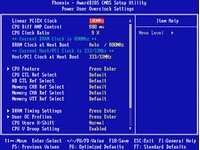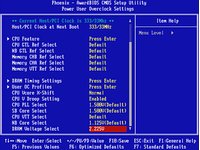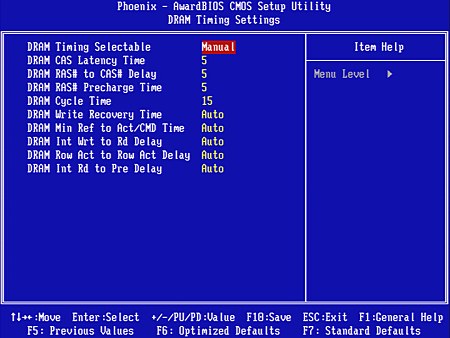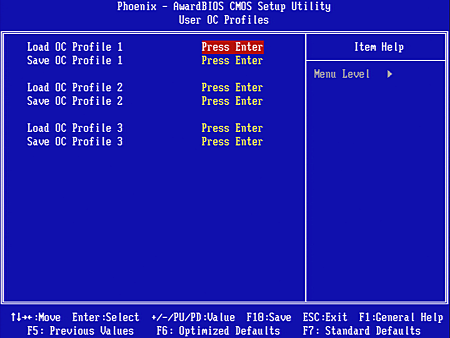11-Way P45 Motherboard Shootout
HI04 BIOS And Overclocking
| FSB Frequency | Stock-700 MHz (1 MHz) |
| Clock Multiplier Adjustment | Yes |
| DRAM Ratios | 1.0, 1.2, 1.25, 1.5, 1.67, 2.0 |
| PCIe Clock | 100 - 200 MHz (1 MHz) |
| CPU Vcore | Stock - +0.750 Volts (0.05 Volts) |
| CPU FSB Voltage | Stock - +120.09% (1.905%) |
| Northbridge (MCH) | 1.125 - 2.256 Volts ( 0.0175 Volts) |
| Southbridge (ICH) | 1.50 - 3.031 Volts ( 0.0235 Volts) |
| DRAM Voltage | 1.85 - 3.285 Volts ( 0.0255 Volts) |
| CAS Latency Range | tCAS : 3-10 ; tRCD : 3-10 ; tRP : 3-10 ; tRAS : 9-24 |
Jetway includes all the settings that most overclockers are likely to use, with adequate frequencies and voltage ranges. We prefer actual voltage settings, rather than plus or minus values, however, and are especially annoyed when forced to calculate percentages to reach our voltage goals.


The HI04 Overclock menu is just over one page long, with settings for CPU multiplier, FSB clock, and key voltage levels.
A DRAM timings sub-menu contains the most frequently adjusted latencies.
Three BIOS configurations can be saved for later retrieval using the User OC Profile utility. These value remain stored even if BIOS is “Cleared”, allowing overclockers to get back to a workable setting after a failed boot attempt.
One other thing we noticed about Jetway BIOS is that its “Onboard Device Function” menu must be entered to enable “USB Storage Legacy Support”, which is disabled by default. We updated BIOS from a bootable USB flash drive after enabling this feature.
Get Tom's Hardware's best news and in-depth reviews, straight to your inbox.
Current page: HI04 BIOS And Overclocking
Prev Page HI04 Onboard Devices Next Page HI04 Software And Accessories-
nickchalk Where are the lower price P45 M/B ?Reply
Asus P5Q pro is out for €110 and P5Q deluxe for €165 the price difference is about 70$ in Greece. -
Proximon I suppose I can get some good from having read this. Did you get paid by the word? Maybe next time you could just put together a complete features chart so that we can have some convenient comparison? You know, so someone could go to a chart and see at a glance which boards had eSATA or firewire, or 8 USB.Reply
-
JPForums I'd rather have the overabundance of information than a lack of information. Presentation could use a little refining (I.E. comparison charts and the likes), but having the relevant information available at least is a good thing.Reply -
the introduction and specifics are nice, the comparision isn't. so, why don't you test with an 8500 or qx9650? 6850 are outdated... and a mobo handling a c2d doesn't mean it can handle a quad too, see P5K for example (it stinks when it comes to a q6600).Reply
-
Crashman procithe introduction and specifics are nice, the comparision isn't. so, why don't you test with an 8500 or qx9650? 6850 are outdated... and a mobo handling a c2d doesn't mean it can handle a quad too, see P5K for example (it stinks when it comes to a q6600).Reply
Tom's Hardware wants the performance of current articles to reflect that of recent articles, so a "standard test platform" was chosen a while ago. It will get updated, but probably not before the new socket becomes widely available. -
zenmaster I would have liked to see something such as a P35 and an X48 as controls to help analyze the P45 Performance.Reply
In otherwords, What is the P45 Gaining me over the older P35.
What would I gain by going to the X48. (Or Lose) -
Crashman zenmasterI would have liked to see something such as a P35 and an X48 as controls to help analyze the P45 Performance.In otherwords, What is the P45 Gaining me over the older P35.What would I gain by going to the X48. (Or Lose)http://www.tomshardware.com/reviews/intel-p45-chipset,1961.htmlReply -
johnbilicki The first 17 pages were filled with nothing but junk from ASUS. Do us a favor: don't even bother featuring or *MENTIONING* anything for any reason from a company that refuses to RMA 200-400 dollar brand new motherboards with anything other then used and usually broken junk. It destroyed my enthusiasm for the article.Reply -
dobby nickchalkWhere are the lower price P45 M/B ?Asus P5Q pro is out for €110 and P5Q deluxe for €165 the price difference is about 70$ in Greece.Reply
the p5q PRo is a p43 board, i should know i have one


